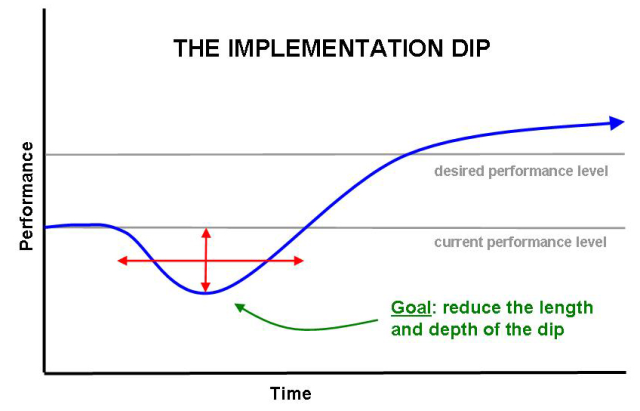Change management can be defined as introducing reforms to the previous or existing systems to meet the desired goals and objectives of the organization. It includes adopting processes, tools, and techniques to achieve the outcome while minimizing the loss of employees, organization resources, and customers. This change can also be thought of as adapting, such as forming a new leadership structure, organizational structure, or introducing new jobs or roles. The importance of adapting can clearly be seen during our pandemic-induced time when change is a must for organizations that want to keep pace with an evolving marketplace.
The goal of effective change management is to optimize operations, effectively allocate resources, and have productive and supported staff while minimizing time spent in the implementation dip.
The implementation dip is the amount of time people and organizations spend in the learning phase of a change. During the learning, overall productivity and effectiveness will drop until the improvement takes hold and the company’s performance reaches the desired level. These tips can help any team, department, or company
The most effective way to change your organization and achieve better results is to alter the approach we take including the types of conversations we have, the behaviors we model, and the processes for getting things done. Here are some 5 most effective tips to successfully manage change in your organization.
Treat it as a project:
To successfully build an organizational competency, not just change management competency but any organizational competency, it is critical to view this work as a project. The project needs structure. It needs someone to manage the project. And it needs a team to evaluate, design, and deploy the approach. “Change management deployment” should be viewed as and managed as a project.
Apply a holistic strategy:
To be successful in change management, a holistic and structured approach much be used. 5 key factors i.e. leadership project, process, structure, and skill must all be integrated and specific tactics need to be developed in each of the five areas.
Dedicate a team:
A team needs to be in place to manage the project of “deploying change management”. And to build out the change management plans necessary to manage the people side of this change and to develop the specific tactics that will ultimately bring change management to life in the organization.
Communicate with your employees:
Open communication is a golden thread that runs through the entire exercise of the transition. Providing clear and open lines of communication will help employees to voice concerns, vent frustrations, and share what is working or not. This will help to smoothly run the change management through teamwork.
Monitor risks:
One of the major risks to change management is resistance to change. It is a normal reaction to change but it can threaten the success of a project if not dealt with directly. Anticipating and preparing for resistance by leadership, training and constant monitoring will help mitigate the risk factors.



